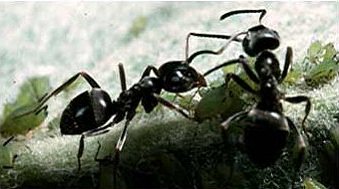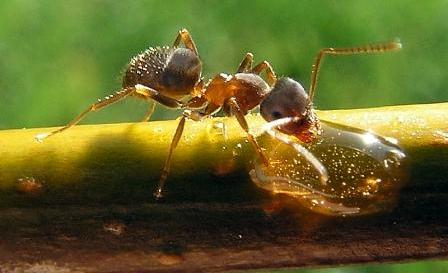|
Garden Ants
View more pictures: Bing Images Google Images Yahoo Images Common names: Ant, Formicidae and myriad of others Scientific name (Family): Formicidae Region: Various species throughout North America Life cycle: Eggs are laid continuously throughout the spring, summer, and fall. Colonies hibernate in the soil or in garden debris. Physical Description: Black, brown, reddish, or yellowish; winged or wingless with a greatly enlarged abdomen. Some have wings and others don't. The body texture may be smooth o rough; the surface may be bar, hairy, or spined. The head is very large with elbowed antennae. The mouthparts are generally well developed with compound eyes , and three ocelli are present except in the workers. The Formicidae may be distinguished from other Hymenoptera by the greatly enlarged abdomen. Feeding characteristics: Many feed on organic matter and dead insects. Some feed on other insects, which may or may not be garden pests. Some Formicidae species invade beehives. They are very fond of honeydew secretions of Aphids, Mealy bugs, and Scales and trend these insects like cows. Controls: A big problems with the Garden Formicidae is mainly associated with the herding of aphids and other insects they feed on. If one is able to control the Garden Formicidae population, control of aphids and other insects may follow. It is best to set up barriers to control the Garden Formicidae. They will not cross lines of bone meal or powdered charcoal. Sticky barriers, such as Tanglefoot, placed around the base of tree trunks are very effective. Search for small Formicidae holes and squeeze lemon juice into it. Then slice up the lemon and place it in the hole or entrance and all around the entrance area. Plants that are known to repel the Garden Formicidae: Pennyroyal (Mentha pulegium) Peppermint (Mentha piperita) Spearmint (Mentha spicata) Tansy (Tanacetum vulgare) Catnip (freshly picked) (Nepeta cataria) Smoke from Oak leaves (in a greenhouse situation). The fumes from Oak leaves are not poisonous to humans, animals, or soil bacteria. Return from Ants to Insects A-D Encyclopedia of Garden Insects |

